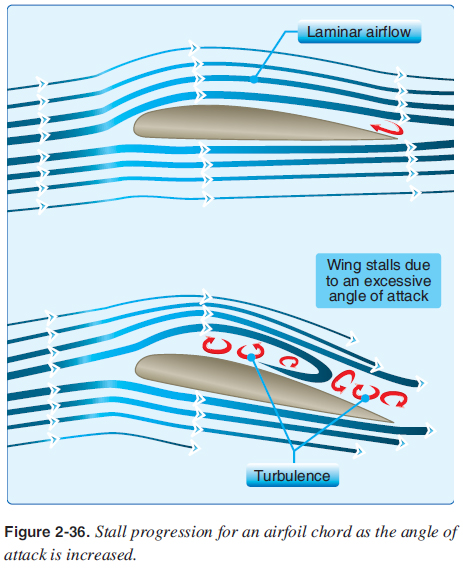
 |
|
||
CHAPTER 2. Aerodynamics Thrust Moments WSC aircraft designs can have different moments caused by thrust based on where the thrust line is compared to the CG. This is similar to an airplane except the WSC aircraft has no horizontal stabilizer that is affected by propeller blast. If the propeller thrust is below the CG [Figure 2-35, top], this creates a pitch-up moment about the CG when thrust is applied and a resultant decrease in speed. When reducing the throttle, it reduces this moment and a nose pitch down results with an increase in speed.  If the propeller thrust is above the CG [Figure 2-35, bottom], this creates a pitch-down moment about the CG when thrust is applied and a resultant increase in speed. When reducing the throttle, it reduces this moment and a nose pitch up results with a decrease in speed. With the thrust line above or below the CG producing these minor pitch and speed changes, they are usually minor for most popular designs. Larger thrust moments about the CG may require pilot input to minimize the pitch and speed effects. Most manufacturers strive to keep the thrust as close as possible to the vertical CG while also balancing the drag of the carriage and the wing for its speed range. This is why the carriage must be matched to the wing so these characteristics provide a safe and easy to fl y WSC aircraft. Stalls: Exceeding the Critical AOA As the AOA increases to large values on the wing chord, the air separates starting at the back of the airfoil. As the AOA increases, the separated air moves forward towards the leading edge. The critical AOA is the point at which the wing is totally stalled, producing no lift—regardless of airspeed, fl ight attitude, or weight. [Figure 2-36]  Because the AOA of the WSC wing root chord/nose is so much higher than the AOA of the tips, the nose stalls before the tips. It is similar to stalling with the airplane canard in which the nose stalls fi rst, the main wing (or tips for the WSC aircraft) continues to fl y, and the nose drops due to lack of lift. In most normal situations, the root chord/nose stalls fi rst because it is at a much higher AOA. The tips continue to fl y, making the WSC wing resistant to a complete wing stall. A pilot can even bring the aircraft into a high pitch angle stall attitude and keep the nose high. The nose stalls and rotates down because of the loss of lift, while the tips keep fl ying and maintain control of the aircraft. If fl ying within the operating limitations of the aircraft and the WSC reaches a high AOA, the nose stalls, but the tips continue fl ying. However, it must be understood that there are many wing designs with many types of stall characteristics for each unique design. For example, high-performance wings could have less twist to gain performance, which could cause the wing to stall more abruptly than a training wing with more twist. |
| ©AvStop Online Magazine Contact Us Return To Books |